Ex-mayors want street grid with Brent Spence Bridge project. If built, what could come?
- Oops!Something went wrong.Please try again later.
- Oops!Something went wrong.Please try again later.
Since its launch, the Cincinnati grassroots group that jumped into planning for the giant Brent Spence Bridge Corridor project has called for a new street grid between downtown and Queensgate.
In the last year, former Cincinnati Mayors John Cranley and Mark Mallory amplified that call as frontmen for Bridge Forward.
Initially focused on recouping near-downtown land for development – something the city of Cincinnati won in late 2022 – Bridge Forward and its high-profile advocates now say that the right street system is essential to make the most of reclaimed land.
But what exactly would a grid look like, and what difference would it make? And would it be worth a possible $100 million price tag?
At The Enquirer’s request, Cranley, Mallory and Bridge Forward founder Brian Boland led a walking tour to explain their thinking just before this week's public hearings on the larger project.
The short version: a “Field of Dreams” strategy. If the city builds the streets, development will come, the three say.
“What makes urban areas a success is this: block after block after block and the opportunity to build things on those blocks that people want to be involved in,” said Mallory, mayor from 2005 to 2013 and now a development consultant.
Added former two-term mayor Cranley, an attorney who succeeded Mallory: “Build a street grid and you get a whole new block of downtown Cincinnati,” from as far south as Third Street to as far north as Ninth.
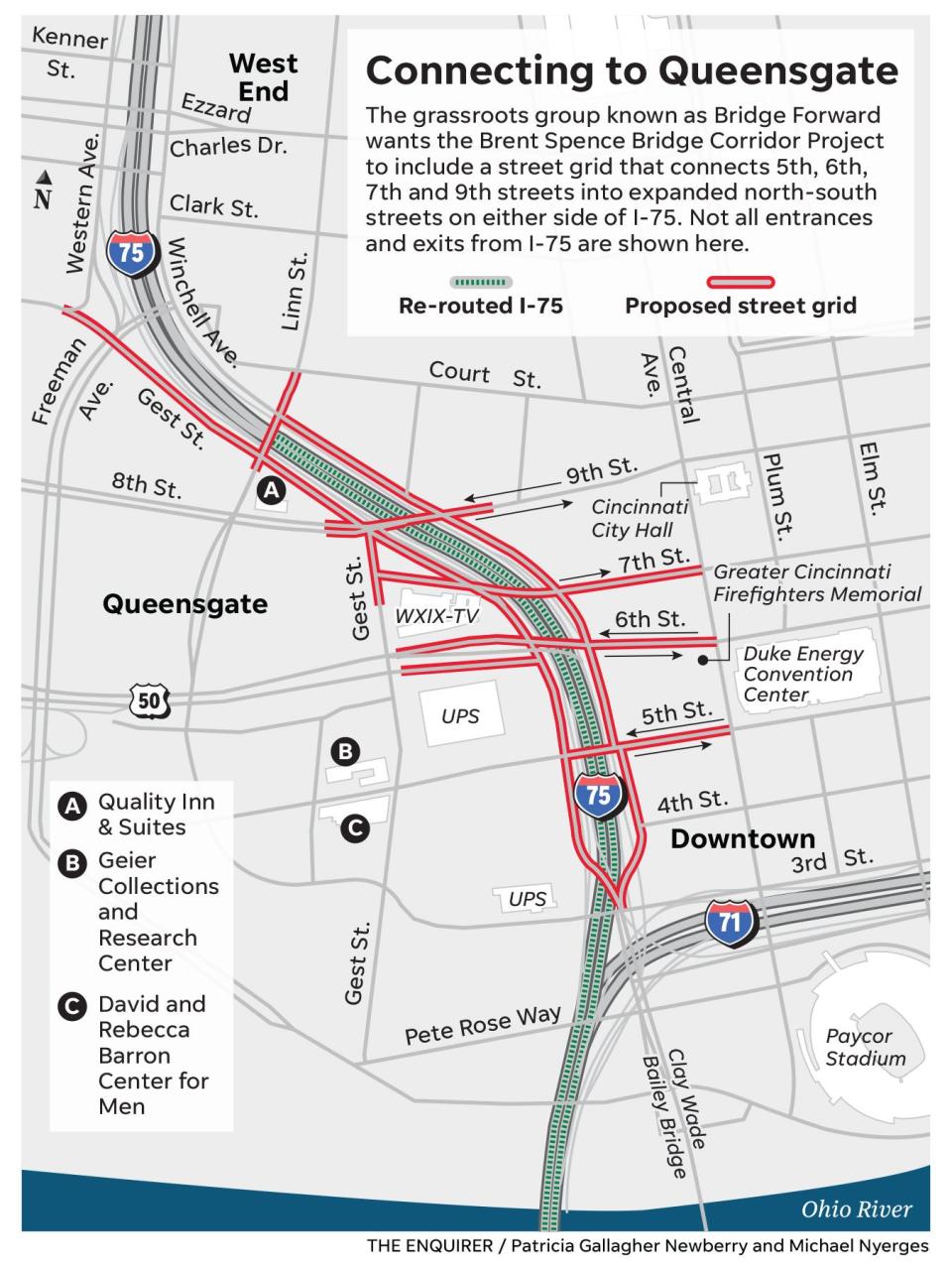
Bridge Forward's grid would provide frame for development
The Bridge Forward map for the $3.6 billion Brent Spence Bridge project proposes remaking four Downtown-to-Queensgate streets and adding to two more.
Under the plan:
Fifth, Sixth and Ninth Streets would run in both directions over Interstate 75, and Seventh Street would remain eastbound only. Right now, Fifth is also eastbound, and Sixth and Ninth are westbound.
The city would extend two north-south streets further south to intersect with Fifth, Sixth, Seven and Ninth. On the east side of I-75, a new roadway would start at Third Street and connect with Winchell Avenue at Ninth Street. A west side extension would also start at Third, then connect with Gest Street, then Western Avenue.
The remade and new streets would be narrower and move traffic more slowly. Right now, vehicles move quickly over three or four lanes on existing streets.
The grid would include inviting sidewalks. At present, the existing streets include a sidewalk on one side – but none are optimal. They lack berms between curbs and walking paths. They need repair and clean-up. The sidewalk on Fifth is narrow; the one on Seventh lacks any fencing or barrier between the sidewalk and street.
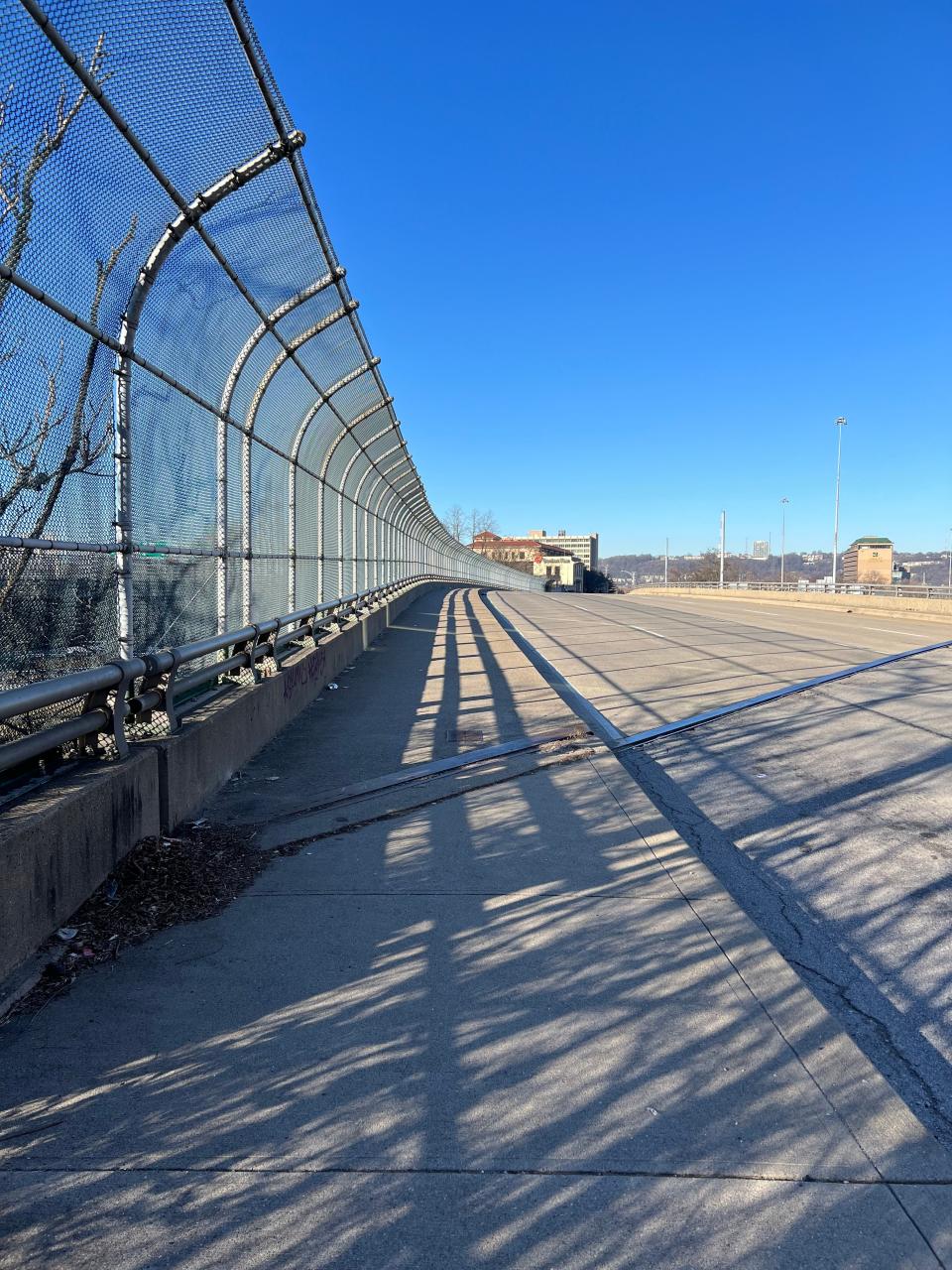
The grid would, essentially, provide a frame for new development on both sides of I-75. On the east side, the grid would create access to 9.5 acres along Central Avenue that Ohio is returning to Cincinnati. On the west side of the interstate, the grid would create new options for Queensgate growth.
Bridge Forward says state officials have told them their grid idea would cost roughly $100 million.
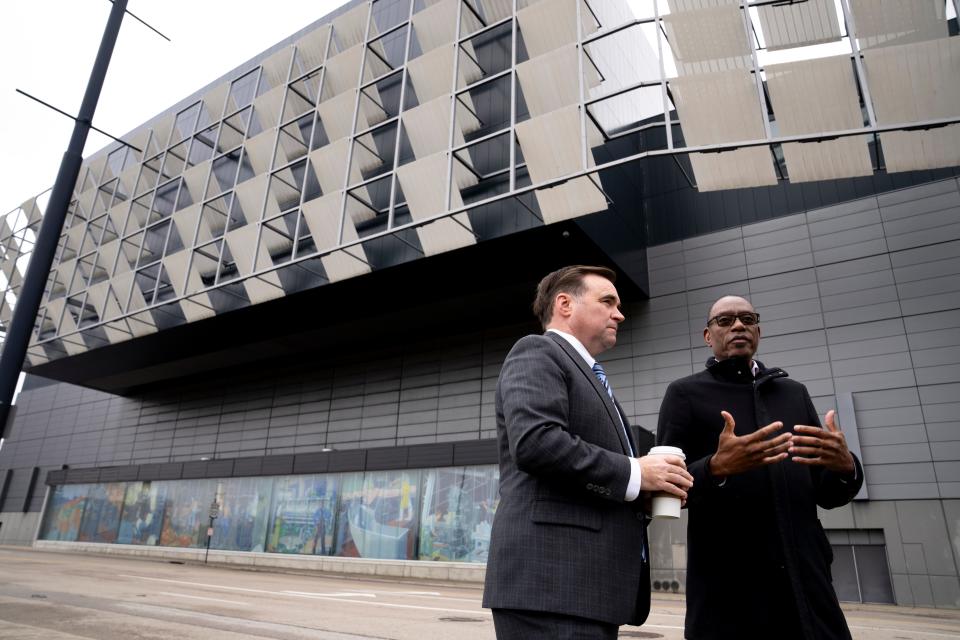
If you build it, what would come?
Ohio was able to promise Cincinnati the near-downtown acres as bridge planners revised designs. Part of the land came from planned changes to I-75 entrances and exits, three of them requested by the city.
Early on, Bridge Forward suggested recouped acres could be used for hotels, more convention space, an arena, space for retailers and parks – and a pathway to Queensgate.
“The opportunity is to dramatically expand the footprint of downtown and to open up Queensgate to a walkable, multifamily, mixed-use community,” Cranley said.
That can be hard to imagine, he said, because “right now (Queensgate) is kind of an industrial wasteland.”
“But so was The Banks before we redid Fort Washington Way,” he added, referencing the late 1990s initiative that sank that highway and made The Banks possible south of downtown.
Leaders from government and business must work together to determine the best use of recaptured land, Mallory said. “If you don’t build that street grid, you don’t have a chance to discuss what could be there,” he said.
Those discussions could dovetail with ones that have already spurred projects in and near Downtown:
Duke Energy Convention Center last month unveiled details of a $200 million renovation, scheduled to start this summer.
Multiple hotel projects are in the works, and several office buildings are being converted into living space.
Developers are starting to show interest in Queensgate, with one planning to turn the Quality Inn into a senior living facility and another aiming to turn the former Queensgate Jail into space for entrepreneurs.
Adding a grid to the bridge project now, before designs are finalized and construction begins, tees up future possibilities, according to Bridge Forward allies.
As one of them, homebuilder Greg Fischer, told Cincinnati City Council last fall: “This is not about engineering. We know the engineers can do this if challenged and asked for more. This is about what Cincinnati leaders are willing to push for.”
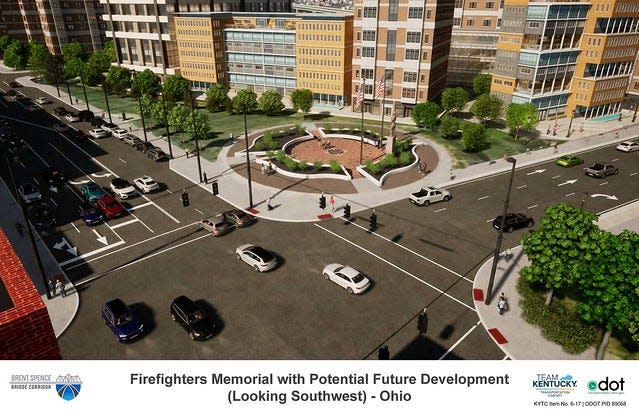
Grid would do right by the West End, too
Cincinnati leaders have, of course, been working with state transportation officials on the Brent Spence Bridge project for years. In late 2022, those efforts won them the land along Central Avenue and the changes to interstate entrances and exits. Last year, they won an OK to widen a planned two-way bridge over I-75 at Ezzard Charles Drive.
City leaders share Bridge Forward’s aspirations for the west side of Downtown and Queensgate too.
Like Bridge Forward, they want a new north-south street on the east side of I-75. They want a new intersection in Queensgate, too, where Eighth and Ninth streets meet at Gest.
They also want to do right by the West End, part of which was turned into Queensgate in the 1960s.
That was after a West End enclave known as Kenyon-Barr was razed to make way for I-75. Last summer, City Council issued an official apology for decimating Kenyon-Barr and pushing out some 25,000 mostly Black residents.
“Lots of shops and restaurants and bars and theaters and barber shops and beauty shops – all wiped out,” said Mallory, a West End native.
A street grid that allows for new development is “a real opportunity to bring back some part of that,” he added.
Opening the west side of downtown and Queensgate to growth could help the entire West Side, said Cranley, who grew up in Price Hill.
“The West End and the West Side has always felt ignored and forgotten by downtown," he said. "There’s a gulf, a gap. This is an opportunity to close that gap.”
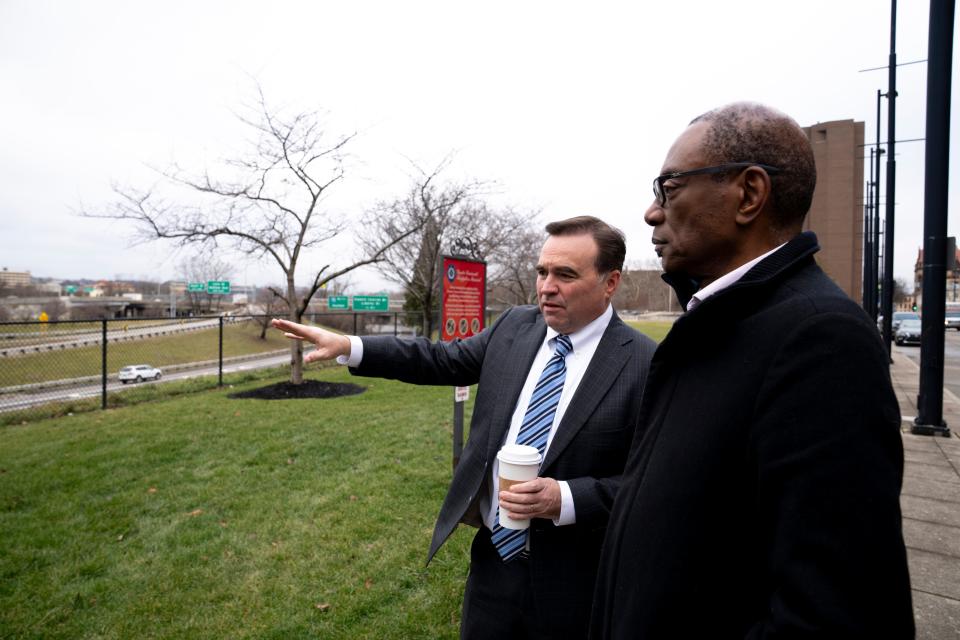
Bridge Forward pressing case with city, state of Ohio
City support for the Bridge Forward street grid idea has been more muted. Council members passed a resolution last May essentially endorsing efforts to get more from the bridge project. But they’ve not offered a full-throated endorsement of a street grid or a promise to fund it.
Bridge Forward is continuing to press its case with the council’s Climate, Environment and Infrastructure Committee.
Asked about the grid idea, Mark Jeffreys, one of the committee’s four members, said the city “should continue to push the objective of reconnecting the parts of our city that have been bifurcated by the highways decades ago.” He said he is eager to see how final bridge designs reflect that goal.
Remaining committee members – Meeka Owens, Seth Walsh and Jeff Cramerding – did not respond to requests for comment.
Bridge Forward supporters hope city leaders take a cue from Ohio Gov. Mike DeWine. In a January interview with WCPO-TV, DeWine said local officials should have the last word about street-level features of the Brent Spence Bridge project.
“We defer to the people of Cincinnati. We defer to council and the other business leaders," he said.
His only caveat: that city involvement not slow the project timeline.
State bridge planners, meanwhile, are fueling Bridge Forward's hopes. Their latest document on the project, out last month, says "design concepts submitted by the Bridge Forward Coalition" remain under evaluation. Design work should wrap up in late spring or early summer, a state spokesman said.
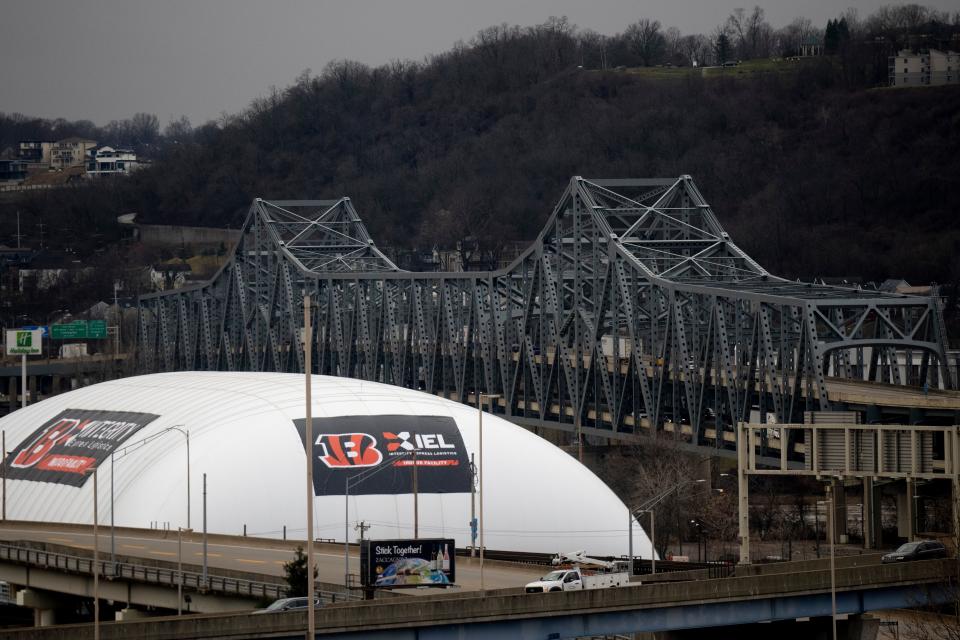
'We know what the city needs'
People who work or live downtown can reach Queensgate in minutes by car or foot. But unless they are craving White Castle, visiting Fox's WXIX-TV station or doing business with the Flying Pig Marathon, they don’t have many reasons to make the trip.
That section of Queensgate lacks restaurants, retailers, housing, recreation or other amenities, instead housing mostly the kind of industrial employers that operate amid the neighborhood's sprawling rail yards.
A new report offers some hope for change. Future plans for Queensgate (along with Camp Washington) should include residential and mixed-used commercial projects in addition to industrial ones, an Urban Land Institute report recommends.
A street grid is critical to such plans, according to the former Cincinnati mayors. That’s why both joined the Bridge Forward cause.
“We know what the city needs,” Mallory said. “We know what proper development looks like. And we also know what kinds of bad transportation infrastructure decisions were made in the past.”

Five public hearings set for this week
Ohio and Kentucky officials have scheduled four in-person public hearings and one virtual meeting about the latest version of the supplemental environmental assessment document guiding the bridge project. The schedule:
Tuesday, noon to 3:30 p.m., repeated 4:30 to 8 p.m., at the Radisson Hotel, 668 W. Fifth St., Covington.
Wednesday, noon to 3:30 p.m. and again 4:30 to 8 p.m., at Longworth Hall Event Center, 700 W. Pete Rose Way, in downtown Cincinnati.
Thursday, 5:30 to 7 p.m., on YouTube.
Participants at the in-person hearings can browse exhibits and other information, talk with members of the project team and offer comment of up to two minutes. Formal presentations will start an hour into each meeting.
The supplemental environmental assessment is already posted on the Brent Spence Bridge project site, with comments underway. Paper copies are available at the Kenton County Library at 502 Scott St. in Covington and the Cincinnati & Hamilton County Public Library's West End branch at 805 Ezzard Charles Drive.
This article originally appeared on Cincinnati Enquirer: Cranley: New streets over I-75 could turn Queensgate into The Banks

